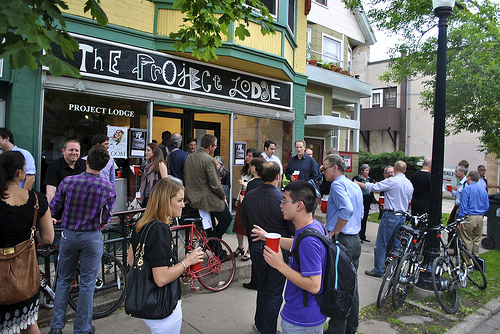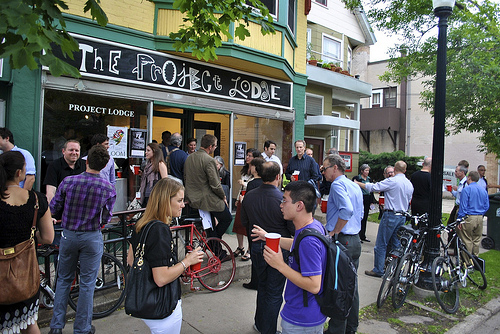 Creating the new New Urbanism, on the street in Madison, with plenty of beer.Photo: Aurash KhawarzadLast week, the Congress for the New Urbanism (CNU) held its 19th annual meeting in Madison, Wisc. You may not have heard of the CNU, but you have almost certainly seen its influence in American development. The movement — which actually kicked off 30 years ago in Seaside, Fla., the town that later served as a set for The Truman Show — isn’t so new anymore. Its ideals of density and walkability, with their attendant environmental benefits, have been absorbed into the planning practices of many municipalities around the country. The New Urbanism has, in many ways, become an old-school orthodoxy.
Creating the new New Urbanism, on the street in Madison, with plenty of beer.Photo: Aurash KhawarzadLast week, the Congress for the New Urbanism (CNU) held its 19th annual meeting in Madison, Wisc. You may not have heard of the CNU, but you have almost certainly seen its influence in American development. The movement — which actually kicked off 30 years ago in Seaside, Fla., the town that later served as a set for The Truman Show — isn’t so new anymore. Its ideals of density and walkability, with their attendant environmental benefits, have been absorbed into the planning practices of many municipalities around the country. The New Urbanism has, in many ways, become an old-school orthodoxy.
Still, there were a lot of young people at the conference — planners, architects, engineers — who are excited about taking urbanism forward. Members of the CNU NextGen group could often be found at a rundown rented storefront they christened the Urban Project Lodge, about a mile from the glossy Monona Terrace convention center where the official panels were happening. The Project Lodge was filled with conversation and argument and ideas (also, lots of beer and free wifi).
Many of the people who hung around the Project Lodge are interested in urban improvement projects that can be done fast, and flexibly, and cheap. They realize that in this economic environment, huge projects and ambitious master plans — the kind of thing that has defined New Urbanism to some extent — are unlikely to be completed in large numbers.
So many of them are concentrating on a whole new toolbox of techniques that allow citizens and governments to fix urban problems (many of them created by the automobile) without waiting around for years in the permitting process, and without spending tons of money. Things like incremental sprawl repair, in which the focus is on rehabilitating individual buildings or even just bringing mobile vendors to parking lots.
Some members of the NextGen group are also using a set of approaches that they call Tactical Urbanism — including guerrilla gardening, pop-up cafés, food carts, “Pavement to Parklets,” and “Build a Better Block” efforts.
I’ve written about the Tactical Urbanism handbook here before. But seeing the tremendous enthusiasm of its practitioners, like Mike Lydon and Aurash Khawarzad, made me realize just how much could be done with this approach. These people aren’t just talking about changing the places where they live and work. They are doing it. Smart, fast, cheap, flexible, nimble, open-source –it’s the new New Urbanism.
If you’re interested in more details on what happened at CNU19, Tim Halbur has a good writeup at Planetizen.



